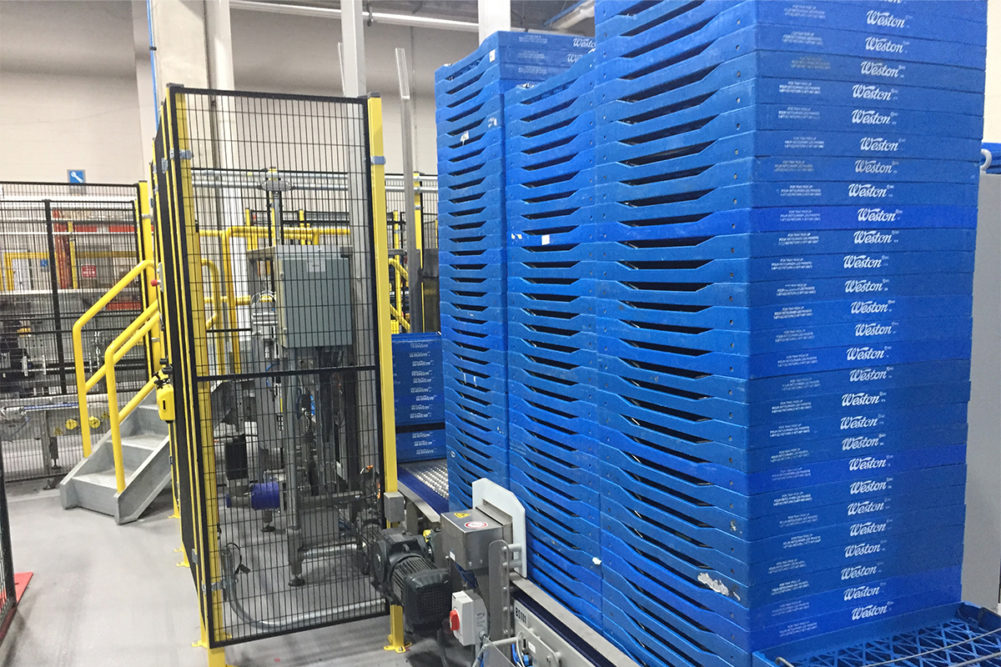Bakers shouldn’t allow the labor shortage in warehousing to turn them into a basket case. That’s because many solutions are now available, and the future promises to bring greater advances in automation, sooner rather than later.
Apex Motion Control uses its Baker-Bot, a collaborative robot or cobot, to automatically move baskets from the packaging department through warehousing.
“It always shows up for work, never gets hurt, never takes breaks or goes on holidays,” said Martin Riis, business development manager, Apex Motion Control. “It basically does the dull, dangerous, dirty and repetitive, non-value-added tasks like tray handling.”
Harpak-ULMA noted it offers cobots with highly advanced, integrated safety capabilities that employ onboard sensors to monitor for risk of operator collisions and act to avoid them, thus allowing people to work next to them. Using cobots not only improves deployment options, but also eliminates the need for safety fences and interlocks.
The company also provides consistently reusable plastic totes, or baskets, that are hygienic, easy to clean and resistant to water and chemicals. Harpak-ULMA pointed out that plastic totes have been shown to reduce product damage by up to 96% while lowering costs by as much as 27% through more efficient, reusable distribution processes.
Patrice Painchaud, vice president of sales and marketing, Rexfab, said the company offers automated guided vehicles (AGVs) and a dolly loader that can carry up to four stacks of loaded baskets to the shipping docks.
Ken Mentch, automation sales manager for VEMAC and Stewart Systems, which are Middleby companies, pointed out that the company has installed AGVs are guided by magnets or wires in the floor to transfer troughs and pans. LGVs, however, rely on a laser on top of the vehicle to see the targets strategically placed throughout the bakery to know exactly where it is at any given moment.
“Lasers are very accurate and versatile,” he said. “You can quickly and easily change routes by modifying the software to create a new mission for the laser-guided vehicle without having to add more wires or magnets into the floor.”
Recently, Mr. Mentch has been testing LGV technology from its VEMAC division to determine how the vehicles can pick up and move baskets full of bakery products.
“We’re going to incorporate Key-Log, the Middleby company that does gantry robots, and be able to deliver the full stacks or create partial building of stacks,” Mr. Mentch explained.
By incorporating data from pick-to-light and other warehouse management systems, the LGVs and gantry robots will even build stacks consisting of multiple products.
“We’re looking to take three baskets of Product A, four of Product B, two more baskets of Product C and three more of Product D, and then have the LGV pick up that stack from the robot cell and deliver it to the truck dock as well,” he said.
In some ways, he added, it’s similar to what LGVs do for Amazon and other state-of-the-art distributors.
“We’ll get the information off the production line, and as the basket stack is kicked out of the stacker, we know what product it is, where we’re shipping it to, and that will create a mission for the LGV to pick up that stack and move it to that specific truck dock to be loaded up on that truck,” Mr. Mentch said.
LGVs also come with safety devices that indicate if something, or someone, is blocking its pathway. Overall, he noted, the number of LGVs needed will depend on how many baskets of product a production line cranks out per hour as well as how far the vehicles need to travel to the docking area and back.
“It’s all about cycle times,” Mr. Mentch pointed out. “Typically, a bakery may need four to six LGVs for all of their basket movement requirements. If you have more than that, it could lead to the law of diminishing returns whereas the LGVs will get in the way of one another.”
For bakeries, the future of the warehouse is rapidly changing and becoming more user-friendly with easy-to-navigate, app-based touch screens.
“Designing fun, intuitive and easier-to-use automation is a constant goal of Apex Motion Control,” Mr. Riis said. “One of the things we like to say is, ‘If you can use a tablet or a cell phone, you can use a Baker-Bot.’ As a matter of fact, a high percentage of our customers have named their Baker-Bots, such as Lucy for Lucille Ball and Pikachu, a Pokémon character.”
The bakery of the future could be right around the corner.
This article is an excerpt from the October 2021 issue of Baking & Snack. To read the entire feature on Trays & Baskets, click here.






